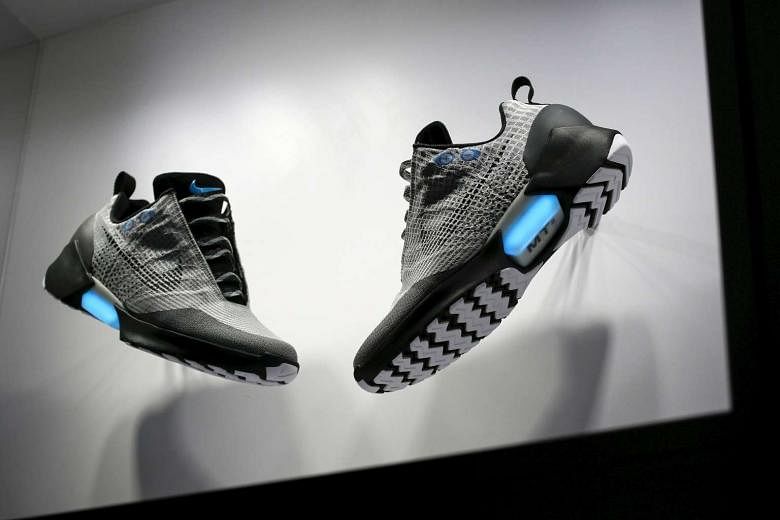NEW YORK (Bloomberg) - With the new self-lacing sneakers by Nike, tripping over loose laces will become history.
The American sportswear giant unveiled the kicks, not unlike those showcased by a baby-faced Michael J. Fox in Back To The Future II at an event in Manhattan on Wednesday.
Nike's public relations team - perhaps failing to recall the well-remembered 1989 movie - breathlessly promised the shoe would "manifest the unimaginable." As usual, the company delivered an over-the-top event, flying in hundreds of journalists, a busload of Foot Locker executives, and comedian Kevin Hart.
The shoe, however, was not a shock. Nike has held a patent for a self-lacing system since 2013, and in October it gave a prototype pair to Fox.
AFP reports that sensors at the heel level activate the lacing when a foot slips into the shoe and two buttons on the side of the shoe can be pressed to loosen or tighten the lacing. Nike calls the feature "adaptive lacing".
Nike's ultimate plan is to make a version of the system that adjusts the fit automatically as an athlete's foot moves. This is why Nike dubbed its robot sneaker Hyperadapt 1.0.
And unlike most movies, the sequel is expected to be much better than the original.
"In the future, this thing will come alive," Nike designer Tinker Hatfield said. "It's not a gimmick."
The price of Hyperadapt 1.0 has not yet been announced.
In addition to a bunch of other new products, Nike also promised to release a new app in June, which has the potential to drive far greater returns than any sneaker. Nike launched its first app in 2006 but its technological performance has thus far been more akin to that of Michael Jordan the forgettable baseball player than to Michael Jordan the basketball star.
The company currently has about six apps, a sort of grab bag of narrow focuses. There is one for tracking runs, and another for downloading work-outs that are not runs. One to track general activity with Nike's now largely defunct Fuelband, and one to track it without.
Finally, a couple are focused on selling shoes. If reviews are any guide, they are a mixed bag. Nike no longer says how many people are using its apps.
The company hopes the new offering, dubbed simply Nike+, will be the one to rule them all - a flexible platform that is part social network, part activity archive, part personal trainer, and part Nike store.
More importantly, the platform should help Nike keep up (or catch up) with Under Armour, which has been buying established app platforms rather than trying to build them from scratch. Since late 2013, the Baltimore company has spent almost US$1 billion (S$1.36 billion) on fitness and diet apps, a shopping spree that has helped it build a community of 150 million smartphone athletes.
Under Armour chief executive Kevin Plank has been clear that he sees technology as an area where the company can narrow Nike's lead in the sportswear game.
Nike executives, however, know what they do best: sell shoes in all shapes, sizes, and colours.
At the launch on Wednesday, Nike released nine new shoes, and that is not counting the self-lacing pair and all the other ones at the big innovation summit in New York. Even with Steph Curry on its endorsement roster, Under Armour pales in comparison when it comes to actually releasing new footwear.
Wisely, some of the most prominent features on Nike's new app will be early access to limited-edition sneakers, a chance to skip the line at coveted releases, and a tool to design custom footwear.
Interested in the new self-lacing kicks? They will go on sale in June. And they will be available on the app first.

